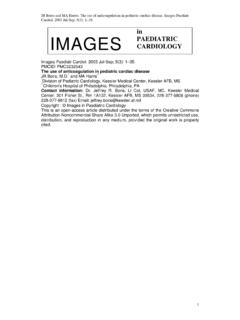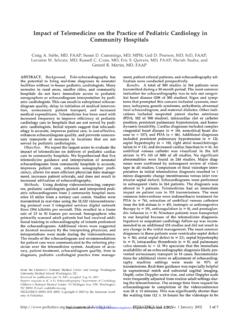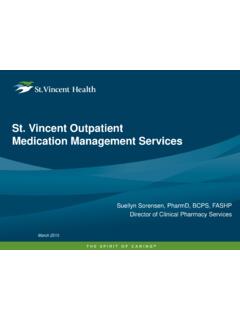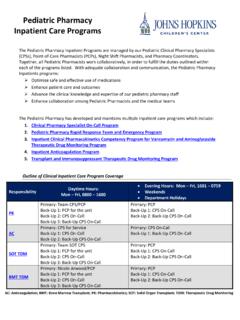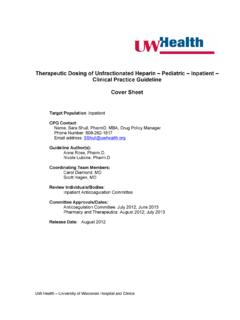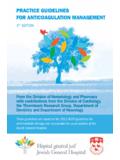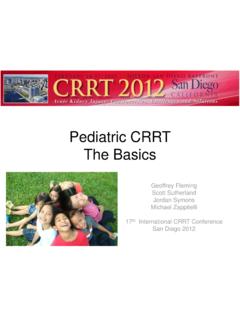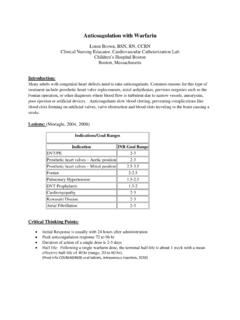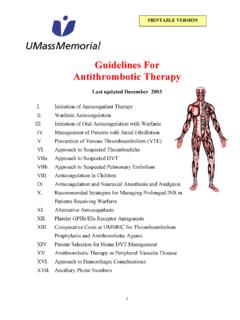Transcription of Paediatric Thrombosis and Anticoagulation Guidelines
1 Filename: Paediatric Thrombosis and Cardiff and Vale UHB Version: 1. Anticoagulation Guideline Paediatric Directorate Author: Philip Connor (Cons Paed Haem) Date of issue: 24/Apr/2015. Ratified by: Sybil Barr, Dirk Wilson, Raza Department of Paediatric Haematology Page 1 of 24. Alikhan, Anthony Lewis Paediatric Thrombosis and Anticoagulation Guidelines Contents Introduction 2. Section A Management of Thrombosis The Neonate/PICU 3. Venous Thrombosis 3. Arterial Thrombosis 4. Paediatric cardiology 5. Indications for Use of Aspirin 5. Devices and Stents 6. Valve replacement 6. Cavopulmonary shunt/Fontan 7. Other indications 7. The Cancer Patient/General Paediatrics 8. Central Venous Sinus Thrombosis 8. Lower limb DVT 8. PE 9. Upper Limb DVT and Hickman/Portacath associated thrombi 9.
2 Extrinsic compression due to tumour 9. Thromboprophylaxis 10. Section B Safe Use of Medicines Low molecular Weight Heparin 11. Unfractionated Heparin 12. Protamine rescue 13. Warfarin 13. Tissue-type plasminogen activator (rt-PA) 14. Appendix A. Enoxaparin Preparation Guidelines 16. Procedure for the home administration of subcutaneous Clexane/LMWH by parent/carer 17. Teaching Checklist for home administration of subcutaneous medication by patient or carer 19. Appendix B. Cardiff and Vale UHB: Paediatric Warfarin Care Pathway 20. Paediatric Inpatient Warfarin Treatment Chart 22. Appendix C. Cardiff and Vale surgical thromboprophylaxis risk assessment Approved by Quality and Safety Committee on: Latest review date: Filename: Paediatric Thrombosis and Cardiff and Vale UHB Version: 1.
3 Anticoagulation Guideline Paediatric Directorate Author: Philip Connor (Cons Paed Haem) Date of issue: 24/Apr/2015. Ratified by: Sybil Barr, Dirk Wilson, Raza Department of Paediatric Haematology Page 2 of 24. Alikhan, Anthony Lewis Paediatric Thrombosis and Anticoagulation Guidelines Introduction Compared with adult patients the incidence of thromboembolic disease in children is much lower. As with fluid management, treatment of infection, glycaemic control etc. all doctors caring for in-patients (whatever their age) should have a working knowledge of the safe and correct use of Anticoagulation . Unfortunately unless some care is taken it is possible to get the process wrong with potentially devastating consequences. The clinician must walk the knife edge between the dangers of thrombi and the perils of over Anticoagulation .
4 The guideline will be divided into 2 sections: A) Management of Thrombosis There are several common scenarios in Paediatric Thrombosis and they most easily split into 1) The neonate/PICU. 2) The cardiac patient 3) The cancer patient/General paediatrics B) Safe Use of Medicines The anticoagulants themselves are potentially dangerous agents and require careful prescribing within a Quality Managed System. This document is part of that system. All anticoagulants commonly used in children require dose monitoring Generally LMWH is preferred. Check renal function, FBC and clotting screen before use. Use UFH if there are concerns about possible bleeding. Check renal function, FBC and clotting screen before use Use Warfarin/asparin for specific cardiology indications Over & under dosing with Low Molecular Weight Heparin (LMWH) is a common error given the dose size of the commercial vials/syringes.
5 UHW Hospital pharmacy will prepare suitable syringe doses for neonatal patients. See page 16. Warfarin and Unfractionated Heparin (UFH) are notoriously difficult to get in range . These Guidelines are a much shorter, locally adapted version of the 2012 9th edition of the American College of Chest Physicians guidance: Antithrombotic Therapy in Neonates and Children:Antithrombotic Therapy and Prevention of Thrombosis , 9th ed: American College of Chest Physicians Evidence-Based Clinical Practice Guidelines . CHEST 2012;. 141(2)(Suppl):e737S e801S. Approved by Quality and Safety Committee on: Latest review date: Filename: Paediatric Thrombosis and Cardiff and Vale UHB Version: 1. Anticoagulation Guideline Paediatric Directorate Author: Philip Connor (Cons Paed Haem) Date of issue: 24/Apr/2015.
6 Ratified by: Sybil Barr, Dirk Wilson, Raza Department of Paediatric Haematology Page 3 of 24. Alikhan, Anthony Lewis A) Management of Thrombosis The Neonate/PICU. Neonatal Thrombosis is rare and occurs in admissions to the neonatal unit. The evidence base for the management of neonatal Thrombosis is minimal and is largely based on case series and extrapolated data from adult literature. Thrombotic events on PICU are frequently associated with intravascular catheters and can be managed in a similar way Predisposing factors: Include indwelling intravascular catheters, congenital heart disease, polycythaemia, poor deformability of neonatal red cells, shock, sepsis and dehydration. Congenital prothrombotic disorders account for 5-20% of all thrombotic episodes and they should be considered in any neonate with a clinically significant Thrombosis , spontaneous thrombotic events, unanticipated or extensive venous Thrombosis , ischaemic skin lesions, purpura fulminans or family history of purpura fulminans.
7 Venous Thrombosis Venous thrombi constitute about 65-75% of all neonatal thrombotic events. Over 80% are central line related. Umbilical venous catheters must be correctly placed (in the IVC- not in the portal veins) and used for as short a period as possible. Clinical presentation will depend on thrombus location, but in general occurs with loss of catheter patency, swollen, painful and discoloured limb. Superior vena caval obstruction presents with swelling of the face and neck and chylothoraces. Pulmonary thromboembolism presents with respiratory compromise. Renal vein Thrombosis presents as a palpable flank mass, haematuria, proteinuria, renal impairment and thrombocytopenia. Oedematous, cold, discoloured lower limbs may indicate extension of the thrombus into the IVC.
8 Portal vein Thrombosis is often difficult to identify by clinical means. An USS of the portal system may be considered if there is unexplained thrombocytopenia in a sick neonate. Management: Remove the indwelling catheter. Precious lines can be salvaged by Anticoagulation but this is beyond the scope of this guideline and must be discussed with Paediatric /Coag Haematology 1. Doppler ultrasound and discuss with radiology regarding contrast venogram. 2. Small thrombi related to catheters/obvious cause with no family history of venous thrombo-embolic disease may not need thrombophlia screening blood tests 3. Extensive skin necrosis occurs in Protein C or S deficiency. This is termed purpura fulminans and is a medical emergency. Check Protein C and S in the baby (1 Paediatric coagulation bottle for this specific test) and contact the Coagulation Haematology team for Protein C concentrate and advice 4.
9 Extensive thrombi, those arising without any obvious cause and in patients with a family history of venous thromboembolic disease may warrant further testing. Contact Paediatric Haematology or Coagulation Haematology team. 5. Monitor limb swelling, temperature and discolouration. 6. Monitor renal function and blood pressure if renal vein thrombosed, arrange nephrology referral. 7. Anticoagulation : Consider for any extensive deep vein Thrombosis , renal vein Thrombosis with IVC. extension or renal failure. Start low molecular weight heparin. LMWH is preferred in neonates due to reduced risk for bleeding, no need for venous access and reduced monitoring requirements. Use unfractionated heparin (UFH) if LMWH is unavailable, or in cases where there may be a need to stop Approved by Quality and Safety Committee on: Latest review date: Filename: Paediatric Thrombosis and Cardiff and Vale UHB Version: 1.
10 Anticoagulation Guideline Paediatric Directorate Author: Philip Connor (Cons Paed Haem) Date of issue: 24/Apr/2015. Ratified by: Sybil Barr, Dirk Wilson, Raza Department of Paediatric Haematology Page 4 of 24. Alikhan, Anthony Lewis the Anticoagulation or reverse the effects quickly ( patient requiring surgery or bleeding) and in renal failure (LMWH is excreted by kidneys). Please see the LMWH and heparin Guidelines in part (B). If the thrombus is large consider using antithrombin/FFP as an adjunct to heparin. 8. Treat for 3 months then stop. If VTE occurs after this then restart Anticoagulation and consider continuing for life 9. Thrombolytics are rarely indicated in venous thromboembolism Arterial Thrombosis Arterial thromboses account for 25-35% of all neonatal thromboses and are almost exclusively secondary to indwelling arterial catheters.

